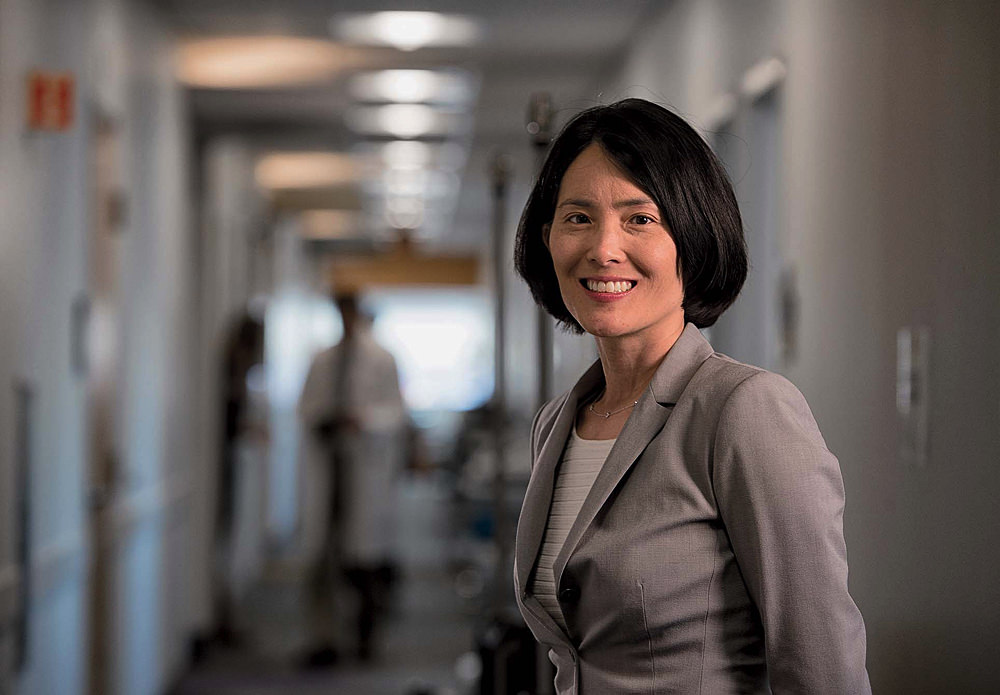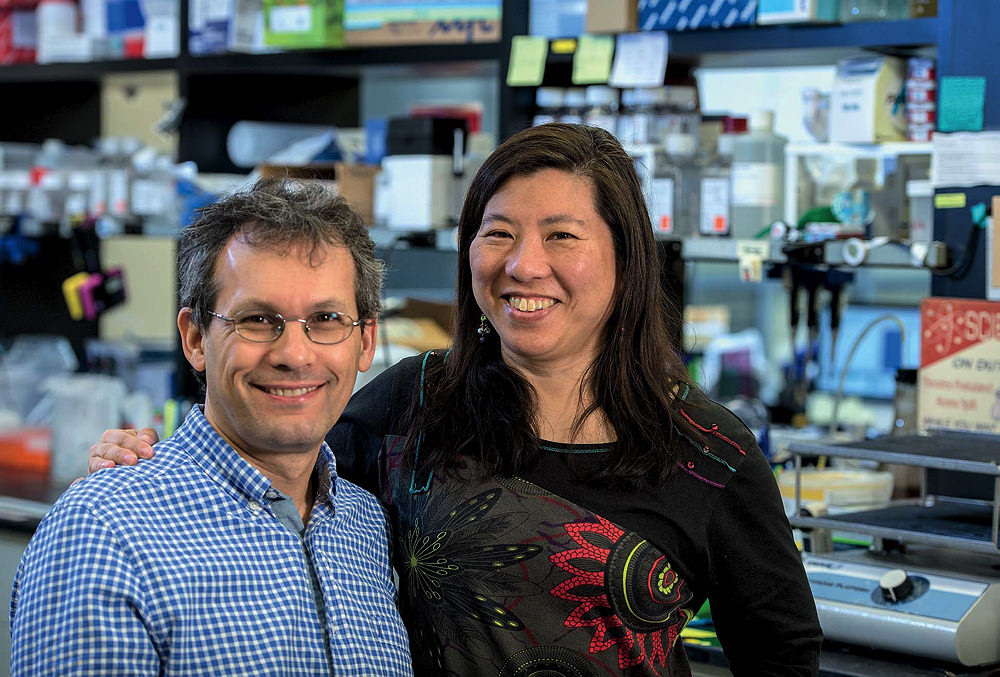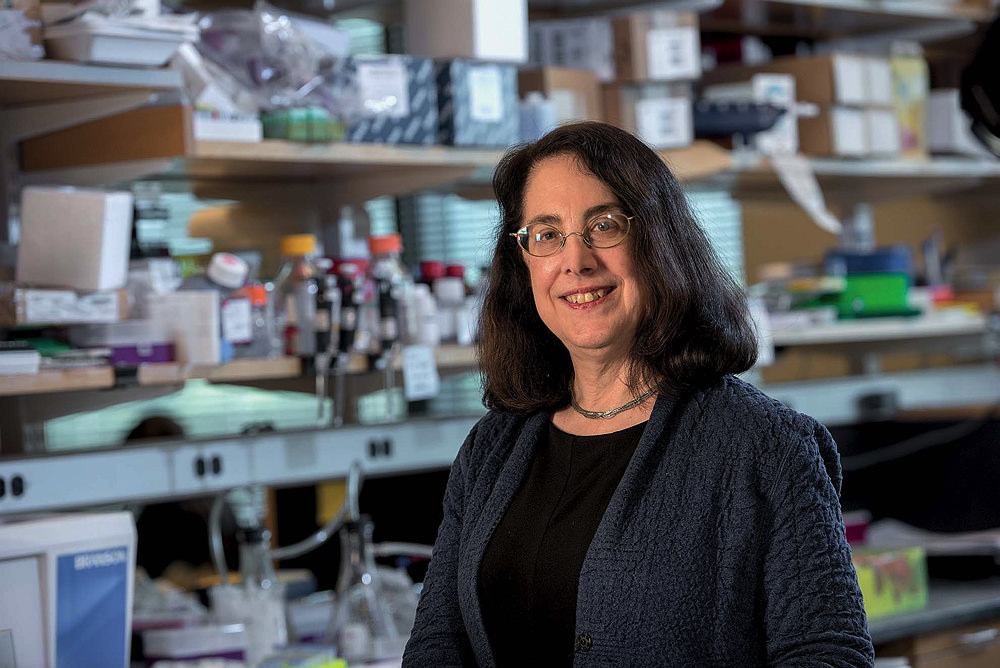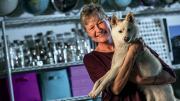Linnea Olson tells her story—of repeatedly facing death, then being saved by the latest precision therapy—articulately and thoughtfully, agreeing to discuss subjects that might otherwise be too personal, she says, because it could benefit other patients. She lives in an artist cooperative in Lowell, Massachusetts, in an industrial space, together with her possessions and artwork, which fill most of an expansive high-ceilinged room. Olson is tall, with close-cropped, wavy blonde hair, and dresses casually in faded blue jeans. Although she has an open, informal style, this is paired with a natural dignity and a deliberate manner of speaking.
“I had a young doctor who was very good,” she begins. “I presented with shortness of breath and a cough, and also some strange weakness in my upper body. And he ordered a chest x-ray.” Years later, she saw in her chart that he had written, “On the off chance that this young, non-smoking woman has a neoplasm”—the beginnings of a tumor in her left lung. But he didn’t mention that to her, and “he ended up getting killed on 9/11—he was on one of the planes that hit the towers.”
The national tragedy thus rippled into Olson’s life. Never suspecting that her symptoms could be caused by cancer, she spent the next several years seeking a diagnosis. A string of local doctors told her it was adult-onset asthma, hypochondria, then pneumonia. When antibiotics didn’t clear the pneumonia, a CT scan showed a five-centimeter mass in her left lung: an infection? Or cancer? It was the first time she had heard that word. The technicians told her that at 45, she was too young for that. But a biopsy confirmed the diagnosis. “In 2005, when you told someone they had lung cancer,” a doctor later told her, “you were basically saying you were sorry.” Her youngest son was seven at the time. Olson wanted to live.
Now, 13 years later, she is alive and healthy, a testament to the potential of precision medicine to extend lives. But like precision medicine itself, her story encapsulates the best and worst of what medicine can offer, as converging forces in genetics, data science, patient autonomy, health policy, and insurance reimbursement shape its future. There are miraculous therapies and potentially deadly side effects; tantalizing quests for cures that come at increasingly high costs; extraordinary advances in basic science, despite continuing challenges in linking genes implicated in disease to biological functions; inequities in patient care and clinical outcomes; and a growing involvement of patients in their own care, as they share experiences, emotions, and information with a global online community, and advocate for their own well-being.
Precision medicine is not really new. Doctors have always wanted to deliver increasingly personalized care. The current term describes a goal of delivering the right treatment to the right patient at the right time, based on the patient’s medical history, genome sequence, and even on information, gathered from wearable devices, about lifestyle, behaviors, or environmental exposures: healthcare delivered in an empiric way. When deployed at scale, this would, for example, allow doctors to compare their patient’s symptoms to the histories of similar patients who have been successfully treated in the past. Treatments can thus be tailored to particular subpopulations of patients. To get a sense of the promise of precision medicine—tantalizingly miraculous at times, yet still far from effective implementation—the best example may be cancer, which kills more than 595,000 Americans each year.
Patient 4
In some cases, cancer can be driven by a small number of genes—even a single gene—that can be identified and then targeted. Even in cancers with many mutations, genetic profiling makes it possible to unambiguously distinguish between tumor cells and healthy tissues. That is a great boon in a disease that essentially hijacks the patient’s own biology. Genome sequencing, by precisely defining the boundary between self and non-self, can even enable immunotherapies that kill cancer cells but not others. Still, state-of-the-art precision cancer medicine is something like the surgical airstrikes of the 1960s: vastly better than the carpet-bombing of chemotherapy, but not without risk of collateral damage.
In 2005, when Olson was diagnosed with lung cancer, surgery, chemotherapy, and radiation—so-called cut, poison, and burn therapies—were the frontline treatments. A friend’s husband, a surgeon, recommended that she go to Massachusetts General Hospital (MGH) for the lobectomy that would remove the lower lobe of her left lung. When she woke from surgery, an oncologist, Thomas Lynch, was standing at the foot of her bed. He was running a clinical trial of an experimental drug he’d helped develop, and she fit the profile of a patient who might benefit.
Lung cancer is rare before 45, and most common after 65: the average age of patients diagnosed with the disease in the United States is 70, and the cancers themselves are typically loaded with random mutations, caused by repeated, long-term exposures to airborne toxins, as might occur after a lifetime of smoking. But Olson was young and had never smoked. This meant that her cancer was likely being caused not by many mutated genes, but by a single “driver” mutation. There are now eight well-established driver mutations for the disease. Lynch hoped that Olson would have one called EGFR (epidermal growth factor receptor), the only one then known. But she didn’t.
Lynch explained to her that cancer outcomes traced a bell curve. At one end were those patients who did poorly. Most were in the middle. But at the other end were the outliers, those who lived a long time. “ ‘Tell me about the outliers,’ ” she recalls asking him—“almost like it was a fairy tale.” She was floundering, she says, as she faced post-surgical chemotherapy, dreading its cytotoxic effects. Lynch persuaded her not to give up. “We’re going to take you to the brink of death,” he told her, “but we’re trying to cure you.” She read Lance Armstrong’s book, It’s Not About the Bike, as she went through four rounds of treatment. “It is horrible,” she says, looking back on it. But “I’d get on my little exercise bike and say, ‘I am Lance Armstrong. I can do this.’”
The tumor was unchanged by the chemotherapy. As months passed, Lynch referred to the growing numbers of nodules in her lungs as “schmutz”—never as cancer. He was trying to keep her hope alive.
In 2008, her symptoms returned, and worsened. Her cancer had progressed to stage IV. In a last-ditch effort, Lynch put her on Tarceva, the targeted therapy for EGFR, anyway, “just in case the genetic test had missed something,” he later explained. But as Olson recalls, “I experienced all of the side effects and none of the benefits.” She asked him how long she had to live. “Three to five months,” he told her. “Should I get my affairs in order,” she asked? “Yes,” he said. In distress, she told a social worker to whom she had been referred, ‘I need you to help me learn how to die.’ And instead, she’s really helped me learn how to live.”
It turned out that even though Olson didn’t have the EGFR mutation, genetic testing done when she started taking Tarceva revealed that she had a different single-driver mutation, ALK, for which a phase 1 clinical trial had just begun. Lynch asked if she wanted to participate in this effort to determine optimal dose, side effects, and efficacy. Patient 1, he told her, had appeared to respond to the therapy, but then died—in part because of it. Olson didn’t want to hasten her own death, but reasoned that doing nothing, she would soon die anyway. She signed on as Patient 4.
Within days, she felt better. The side effects were mild. At the seven-week mark, she saw Lynch to review scans of her lungs. What had looked like a blizzard was completely gone. “I went from accepting that I was going to die, to ‘Oh my God, I’m going to live a little while longer,’” says Olson. “It was like a fairy tale.” Lynch made it very clear that this did not represent a cure, and that there was nothing after this. Eventually, he told her, there would be secondary mutations. But she’d been given another chance.

Alice Shaw, Olson's oncologist
Photograph by Jim Harrison
Professor of medicine Alice Shaw, a physician-scientist at MGH who has been working on ALK and its secondary mutations for 10 years, has been Olson’s oncologist since 2009. Lung-cancer treatment has progressed substantially in the last decade, she says, so that molecular profiling of patient tumors is now standard care. Patients eligible for a targeted therapy skip chemotherapy.
EGFR, the first targetable oncogene (a gene with the potential to cause cancer), was discovered in lung cancer in 2004. “The EGFR gene is mutated in about 10 percent to 15 percent of lung-cancer patients in this country,” Shaw says. Olson’s ALK mutation (technically, a chromosomal rearrangment) discovered in lung cancer in 2007, is present in about 5 percent of patients. There are numerous driver mutations for this disease, seven of which can be turned off with new targeted therapies, which work for about 30 percent of U.S. lung-cancer patients—many of whom can return to their normal lives because the pills are fast-acting and don’t cause as much collateral damage as chemotherapy.
That is something that should be considered, Shaw says, when weighing the costs of targeted drugs, which run about $15,000 a month for as long as the patient is responding. “Obviously, $180,000 a year is an enormous cost. The question is, how do you weigh these costs, in light of the life-saving benefits of these drugs?” Some of the newest treatments for lung cancer, such as immunotherapies (see “The Smartest Immunologists I Know,” below) are as expensive as targeted therapies, she reports. And traditional chemotherapy often keeps patients out of work, and sometimes leads to hospitalization—costly outcomes. By contrast, targeted therapies allowed Olson to live relatively normally and raise her youngest son, now 20 and an undergraduate at MIT.
Finding Five Unknown Variables
Miraculous as they are at their best, targeted therapies do not work forever. That’s because genomic instability is one of the defining features of cancer. “I went a full glorious year before I started to have some progression,” Olson recalls. At that time, in 2009, when the cancer began growing again, patients knew they would soon have to leave the ongoing trial. That could have been the end for Olson. But because she had no symptoms from the early progression, and felt well, she was permitted to stay on the experimental drug for almost three years. Then a second ALK inhibitor opened in a phase 1 clinical trial. Fortunately for Olson, the drug was active against ALK S1206Y, the resistance mechanism that had developed in her cancer’s ALK gene, and it bought her 15 more months (although she suffered gastrointestinal side effects as well as liver toxicity, for which she had to be briefly hospitalized). Her therapy has carried on this way, a continuing cascade of genetic analyses as the cancer adapts, and then a new therapy, just in time to save her. The alternative—standard chemotherapy and radiation—typically extends lung cancer patients’ lives by just three to six months.
The development of resistance is less a reflection of the efficacy of targeted therapeutics than of the cancer’s ability to evolve. Cancer cells proliferate through division, and mutate rapidly. If a single cancer cell among millions happens to be resistant to a particular therapy, that cell and its progeny eventually become dominant drivers of the patient’s disease. Shaw studies these mechanisms of resistance; once pathologists sequence tumors, the scientists can identify the mutations and develop models of them, she explains. Working with pharmaceutical companies, the researchers test newer drugs against these mutations to see if the therapies are active. Now that there are several inhibitors for EGFR and ALK mutations, Shaw says, she and her colleagues are beginning to explore combination therapies, hoping to stop the cancer before it becomes more complex in response to single-drug treatments.
Combination therapies are critical against cancer, agrees Peter Sorger, Krayer professor of systems biology and director of Harvard Medical School’s (HMS) Laboratory of Systems Pharmacology (see “Systematic Drug Discovery,” July-August 2013, page 54). He and his postdoctoral fellow Adam Palmer find that many combination therapies are superior to single drugs across a wide range of solid tumors because of tumor heterogeneity. Heterogeneity arises from genetic differences among cells in a single patient and among tumors in different patients; it likely explains why a particular anti-cancer drug can be effective in some patients but ineffective in others with the same type of cancer.
In fact, a graph of patient responses traces a bell curve with a long tail: many patients respond only partially, but some do very well (they lie out on the tail). Combination therapies improve rates of success in patient populations (and clinical trials) in this view simply by increasing the odds that a patient will lie out on the tail. In other words, combination therapy overcomes ignorance of which drug will work best in a specific patient; this is true even when a targeted therapy is given to genetically selected populations.
Such bet-hedging is a case of the glass being half full, Sorger says: “existing combinations have taken untreatable disease in which a metastatic case means you die, to one in which a quarter or more of patients are doing well. At the same time, the large impact of unknown variables is the measure of how far we have to go in cancer pharmacology.”
How do we reconcile this statistical view of responsiveness to cancer therapy with the precise molecular experiments that Shaw and her colleagues are using to design combination therapies for cancers carrying EGFR, ALK, and other mutations? Sorger and Palmer propose that high variability in response to anti-cancer therapy arises because multiple mutations are involved—perhaps six or more in each cancer cell—many of which are unknown. “If we knew all the relevant genes determining drug response in a particular patient, we could be highly predictive, and able to tailor a therapy for each patient,” Sorger says. The studies Shaw has underway are necessary to make such prediction possible in the future. Moreover, in some cases there is evidence that combination therapies can be much more effective than the sum of their parts; there is currently no systematic way to find such combinations at the moment, but they are well worth pursuing. Both Sorger and Shaw agree that, as precision medicine improves and scientists identify the spectrum of mutations involved in drug response, it will be increasingly possible for physicians to tailor therapy to an individual patient’s needs.
Todd Golub, professor of pediatrics and director of the cancer program at the Broad Institute of MIT and Harvard, is part of an ambitious project to find those several targetable genes—and an estimated 10,000 more like them. The aim of cancer treatment, he says, ought to be the use of molecular analysis to make predictions about what the best therapy should be for each patient, for all types of cancer—the ultimate goal of personalized, precision medicine. He and his Broad colleagues are at work on the “cancer dependency map.” Their goal is to identify all the genes that are unique to cancers, on which any cancer depends for growth—the “Achilles heels” of the disease.
Their first challenge is to gather the broadest range of cancer-tissue samples they possibly can. Paired with this effort to collect patient information is a laboratory project to create model cancer cell lines and to test all FDA-approved drugs and drugs that are in clinical development—on the order of 5,000 compounds—against them. “You can’t do that in a patient,” notes Golub. Seeing which compounds are effective against these cancers allows researchers to identify those Achilles-heel genes. “That allows us to create a roadmap for drug developers, so that eventually, we will have a full medicine cabinet to make this concept work,” he explains. Of course there are challenges: some therapeutic targets are critical for normal cells, too. “But we are learning,” he adds, “that in some cases, [inhibiting] the function of a target 24/7 can be horribly toxic, but when therapies are used transiently, tumor cells die, and normal cells don’t.”
The Broad effort is at the beginning stages, with just 500 cancer cell lines, heavily biased toward European ancestry. The fact that whole ethnicities are missing is a measure of how far they have to go. “We’re not going to get there in one fell swoop,” Golub explains. “We’ll get there by keeping people alive longer and longer, until eventually, it becomes a numbers game where the goal is to eradicate all the tumor cells and leave none behind that have drug resistance mechanisms that allow them to escape.” With a complete cancer dependency map, and the molecular profile of a given cancer, physicians could “identify the five drugs predicted to be effective against that tumor. We would put together combinations of drugs that don’t share common susceptibilities to resistance, and unless you had a tumor the size of Manhattan,” there would be no way for the cancer to get around that combination. “We won’t get there during my career for most patients. But for the next generation, I think it is not crazy.”
What Golub is describing is a rational, systematic approach to building a complete arsenal of targeted drug therapies like those that have extended Linnea Olson’s life and the lives of many other patients. Instead of using them serially to extend life, though, he imagines combination therapies that would effect cures. But there is another approach that might yield results for some patients even sooner.
“The Smartest Immunologists I Know”
Immunotherapy is the maverick of cancer research and clinical care, a relatively new strategy in treatment with the potential to cure certain types of cancer now. Harnessing patients’ immune systems to fight cancer represents an approach radically different from that used in targeted drug therapy. There are three distinct techniques: training the immune system using personalized vaccines; reawakening immune cells by stimulating them to recognize cancers through the use of drugs; and engineering a patient’s T-cells outside the body so they will recognize cancer cells and then reinserting those T-cells in patients.
In what may turn out to be the ultimate precision medicine, married professors of medicine Catherine Wu, an oncologist at Dana-Farber Cancer Institute (DFCI), and Nir Hacohen, director of MGH’s Center for Cancer Immunology and co-director of the Broad Institute’s Center for Cell Circuits, have together created personalized cancer vaccines that train the immune system to recognize and destroy cancer cells. In a small clinical trial, they created personalized vaccines for each of six melanoma patients, and let their immune systems do the rest.

Nir Hacohen and Catherine Wu
Photograph by Jim Harrison
The process works by training T-cells, white blood cells that are the immune system’s weapons for identifying and destroying infected tissue, to recognize cancer. Instead of targeting driver mutations, as targeted therapies do, this approach teaches the immune system to recognize random mutations. As Hacohen explains, half of cancer tumors have defects in DNA repair, so tumors develop a lot of random mutations, and the mutated proteins are visible, on cell-surface receptors, to T-cells. “The fact that there is almost no overlap” in these mutations between patients, he explains, “is what makes this approach personalized.” Hacohen and Wu design the vaccines by first analyzing a patient’s immune system, then analyzing her tumor, and finally creating a vaccine that will stimulate her T-cells to bind to a set of perhaps 20 different mutated proteins on tumor-cell surfaces. The trick is to create a vaccine that mimics the mutated proteins. When injected into patients, the immune system recognizes these foreign invaders, and stimulates T-cells that proliferate, recognize, and attack those same mutated proteins on cancer cells. Normal cells, because they don’t have such mutations, are spared.
In each case, radiology of these patients several years later shows no recurrence of disease. Hacohen is reluctant to generalize about the success rate based on such a small sample, but he does note that two other groups (one based at Washington University in St. Louis, one in Germany) have had similar success in trials of cancer vaccines.
Because this approach targets mutations, it is ideally suited for tumors such as smoker’s lung cancer, or melanoma, in which chronic exposure to carcinogens (UV light in the case of melanoma) has driven lots of mutations, creating a genetically noisy landscape. That is because the more genetically complex a tumor is, the more likely the immune system will recognize it as a foreign invader and try to eradicate it. Hacohen’s labs focus on basic immunology, genomics, and systems biology—what he terms “biological equations” that help distinguish cancer cells from healthy ones. Combining his three fields allows him to do the whole-body analysis necessary to distinguish healthy tissue from the foreign molecules on the surface of cancer cells that the immune system can recognize. But Hacohen is a pure researcher; he doesn’t see patients. Wu, an oncologist, does and can run FDA-approved trials with DFCI oncologists to test the vaccines in patients. The combined expertise of this husband-and-wife team is necessary to complete these extremely specialized therapies.
Because this type of therapy is not yet commercially available, the eventual market cost of creating custom vaccines is hard to estimate. At the moment, Hacohen explains, the sequencing of individual patients and their respective tumors costs about $5,000 each, but that price is dropping rapidly. Even the computation required to design a tailored vaccine is relatively limited. What does cost a great deal right now, he says, is manufacture of the resulting vaccine, largely because of all the safety mechanisms that must be satisfied before any custom therapy is deployed in a human patient. That engineering alone might cost upward of $100,000. But this price, too, could fall as personalized vaccine development becomes more widely practiced.

Arlene Sharpe
Photograph by Jim Harrison
A second approach involves reawakening the immune system. In the same way that cancer evolves to resist drugs, it evolves to evade the body’s natural defenses. As cancer begins in a patient, the immune system targets and kills any tumor cells it sees—but left behind to proliferate are the cancer cells that evade the immune system. Immunology researchers like Fabyan professor of comparative pathology Arlene Sharpe have therefore been working to elucidate how cancer disguises itself. Sharpe, who is interim co-chair of the microbiology and immunology department at HMS, heads the cancer immunology program at the Dana-Farber Harvard Cancer Center and co-directs the Evergrande Center for immunologic diseases at HMS and Brigham and Women’s Hospital. She has collaborated with her husband, professor of medicine Gordon Freeman, a molecular biologist and DFCI researcher, to study those pathways.
A key mechanism for defeating cancer’s evasion of T-cell attacks is “checkpoint blockade therapy,” on which Sharpe and Freeman have done much of the basic research. This approach reawakens the immune system to the presence of tumor cells. The surface of cancer cells often display molecules that bind to the inhibitory receptors, known as checkpoints, on T-cells. This stops the T-cells from attacking and killing the tumor.
In normal immune function, Sharpe explains, these inhibitors are critical because they are, in effect, dials that modulate the immune response, turning its sensitivity to foreign objects up or down. Autoimmune diseases such as type 1 diabetes, in which T-cells destroy the pancreas after mistaking it for a foreign invader, illustrate why these inhibitory mechanisms are so important biologically; they prevent the immune system from attacking healthy tissues. But cancer often cloaks itself in molecules that block the immune response. The result is that “the immune cycle often doesn’t work well in cancer patients,” says Sharpe. “Tumors are the smartest immunologists I know.”
But drugs can block these inhibitors, by targeting either their receptors on T-cells or binding partners on the surface of cancer cells. Then, the immune system can suddenly “see” tumors, enabling it to target and destroy them. This T-cell awakening therapy is now being combined with other types of cancer treatment, such as targeted therapies that focus on driver mutations, but Hacohen and Wu have also used it in combination with personalized vaccines that focus on random mutations, in order to make the vaccines even more effective.
A third type of therapy involves re-engineering the immune system by deploying chimeric antigen receptors (CARs): synthesized molecules that redirect T-cells to specific targets. CAR-T therapy, developed at the University of Pennsylvania, has proven highly effective against leukemia, a blood cancer. Assistant professor of medicine Marcela Maus, recruited from Penn, a world-renowned expert in the use of CAR-T therapies who also conducts research as director of the cellular immunotherapy program at MGH, is working to develop such therapies to kill solid tumors.
CAR-T cells are engineered immune cells that recognize specific markers on the surface of cancer cells and attack them. The process involves removing T-cells from a patient, engineering them to target a particular type of cell, growing them in the lab, and then injecting billions of them into the patient. The upside of CAR-T therapies is the “unprecedented elimination of tumors in the majority of patients,” Hacohen explains, “with the downside of toxicity….You’re killing billions of cells in the body in weeks,” a response that dwarfs anything the immune system could stage unaided. This can lead to “cytokine storms,” as huge numbers of cancer cells die almost simultaneously and have to be flushed from patients. Experts in this technique have developed methods for controlling these storms, but the high cost of the approach—as much as $500,000 per patient—has made it the poster child for the troubling economics of modern cancer care (see “Is Precision Medicine for Everyone?”).
Outliers No More
Cost is just one constraint on the aim of ensuring that the best therapies reach the largest possible number of patients. Professor of medicine Deborah Schrag, chief of the division of population sciences at DFCI, makes a distinction between a therapy’s efficacy in a lab or controlled setting such as a clinical trial, and its effectiveness in the population at large. It’s the difference between how well a treatment can work and how well it actually does work given real world conditions. “If a dairy farmer from Maine can’t make it to twice daily radiation treatment in Boston because he has to milk his cows,” that changes the real-world effectiveness of the therapy. Participants in clinical trials are likely to take their medications twice a day exactly as prescribed, but in the routine care context, adherence is imperfect, and that contributes to the efficacy-effectiveness gap. (Key to tracking any intervention’s performance are electronic health records, and Schrag is among the leaders of a cancer data-science effort to develop standards for records used in cancer care; see “Toward a Personal Biomap.”) “Historians of medicine and some prominent skeptics look at the bottom line, and ask what is happening at the population level,” she explains. The reality is that for most patients, advanced lung cancer remains fatal. Leading-edge therapies such as targeted medicine have helped only a subset of the population. “Cancer medicine is the furthest ahead” in the use of genomic analysis to guide therapy, Schrag says, “but it still has a long way to go.”
But patients like Linnea Olson are no longer outliers. Alice Shaw, her oncologist, says Olson’s appearance on an ABC World News broadcast in 2009 made other lung-cancer patients realize that they ought to be genetically tested, too. One of those patients came to MGH, was treated by Shaw, and appeared on the same show the following year, and that led to another generation of patients realizing that they might have a treatable mutation, too. “Now they help each other,” she says. “This has allowed patients to gain access to therapies that they would never have known about otherwise, because even their doctors didn’t know about them. I have this whole tree of patients connected to each other through social media.” One MGH lung cancer patient recently climbed a peak above 20,000 feet in the Himalayas, and was featured in The New York Times. The comments from readers suggested that he must be “an outlier.” Not so, says Shaw: she has many patients who are performing incredible feats and living for years, now that targeted therapies are available. “These patients are not the rare outliers anymore.”
Olson is happy to have the company, but jokes that she needs to stay out front: “If I’m not, that means I’m dead,” she says, laughing. Now four years into her third targeted therapy without any apparent cancer progression, she has instead begun experiencing toxicity from the contrast agents used in the CT scans that are required every few weeks as part of clinical trials. “I figured out the other day that I have known I had cancer for 22.4 percent of my life,” and had more than 150 CT scans. “That is a huge amount. But it is very easy to put into perspective quickly. I am so lucky to have these problems, because I am alive.” Olson still allows CT scans of her lungs, to which her particular metastatic cancer is confined, but not of her abdomen. That means “I’m non-compliant” in the trial, she says. “But I’ve already donated my body to science, and I want to live. Nobody expected any patient like me to live this long.”










